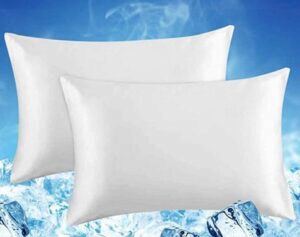How Often Should You Replace Your Pillows?
Disclosure: By clicking on the product links in this article, Mattress Nerd may receive a commission fee at no cost to you, the reader. Read full disclosure statement.
Have you ever had that one favorite pillow? The one that’s the perfect balance of softness and support? The one you couldn’t sleep without?
Some pillows are special. But there comes a time when even the most beloved pillow needs to be retired. How do you know it’s time to say goodbye and upgrade? Let’s break it down.
How Often to Replace Your Pillow
How often you should replace your pillow depends on the material and how much you use it. In general, the collectively agreed-upon lifespan of a pillow is about 2 years. Yep, you read that correctly. Also keep in mind that depending on your sleeping position, your pillow’s lifespan might be shorter, back, side and combo sleeper’s may all be different.
Even if you take impeccable care of them and wash your pillows regularly, they won’t last forever. Once you’ve reached that 2-year mark, it’s time to start looking for a replacement.
Why Should You Replace Your Pillow?
If your tried-and-true pillow is still holding up in the comfort department, you might be wondering why you’d ever have to get rid of it. The answer comes down to hygiene.
As your face lays on the same pillow night after night, it can collect hair, skin cells, and sweat. Over time, these can be absorbed into the pillow. This buildup can trigger all sorts of reactions like acne and allergies—especially if you’re not diligently washing your pillow and pillowcase on a regular basis.
Dust mites are another reason to consider giving your favorite pillow the boot. These tiny creatures thrive in warm, humid environments—exactly the kind of environment you create when you sleep. They also survive by eating the thousands of microscopic flakes of skin we shed every day. So as you might imagine, your pillow is prime real estate for a dust mite infestation.
Allergen covers and regular washing can keep dust mites at bay, but they’re not foolproof solutions. The best way to make sure your pillow is free of them is to start fresh with a new one every few years.
How to Care for Different Types of Pillows
| Type | Wash | Dry | When to replace |
|---|---|---|---|
| Memory Foam | • Don’t machine-wash • Hand-wash only • Gentle detergent | • Air dry on flat surface • Keep away from direct heat and sunlight • May take up to 24 hours to dry completely | • Every 2 to 3 years |
| Polyester | • Machine wash with warm water• Gentle cycle• Gentle detergent | • Air dry on a clothesline • Machine dry on a low-heat setting | • Every 6 months to 2 years |
| Polyfoam | • Don’t machine-wash • Hand-wash only • Gentle detergent | • Air dry on flat surface • Keep away from direct heat and sunlight • May take up to 24 hours to dry completely | • Every 2 to 3 years |
| Down | • Machine wash with warm or cold water • Always wash two pillows at a time • Extra rinse cycle to get out soap | • Machine dry on a low-heat setting • May take multiple cycles | • Every 2 to 3 years |
| Latex | • Hand wash only • Cold water • Mild detergent or isopropyl alcohol | • Air dry on flat surface • Keep away from direct heat and sunlight | • Every 3 to 5 years |
| Buckwheat | • Do not get buckwheat hulls wet • Remove hulls from pillow case • Follow manufacturer’s instructions for washing pillowcase | • Follow manufacturer’s instructions for drying pillowcase • Do not throw hulls into dryer | • Every 10 years so long as you replace the hulls when they start to wear down |
How to Extend the Life of Your Pillows
While you can’t keep your favorite pillow forever, there are a few things you can do to make it last a little longer.
- Invest in a good pillow protector. This will keep your pillow clean and dry and add an extra layer of protection against dust mites and skin buildup. Just make sure to wash the protector at least every 2 weeks to keep it fresh.
- Wash your pillows and pillowcases regularly. Keeping things clean is the name of the game. Wash your pillowcases once a week and your pillows once every six months to prevent buildup and extend their lifespan.
- Throw tennis balls into the dryer. If you can machine dry your pillow, toss in three to four clean tennis balls to help fluff it up. This is especially helpful for feather or down pillows that tend to get flat over time.
Your pillow will never be as good as new, no matter how often you wash it or fluff it up. But following these tips will help it last a little longer and make sure it stays clean and comfortable.
What About Your Pillowcases?
It’s not all about the pillows—the fabric they’re encased in needs some love, too. Just like your sheets and towels, pillowcases should be washed on a regular basis.
How often you need to wash them depends on how often you use them. If you sleep on the same pillowcase every night, aim to wash it once a week. If you switch things up, you can probably get away with washing them every 2 weeks.
Pillowcases don’t have a definitive lifespan like pillows do, but you should consider replacing them if they start to show signs of wear and tear. Look for things like pilling, thinning fabric, or fading colors.
When it comes to pillowcases, it’s better to err on the side of caution and replace them at least once every 1 to 2 years—as long as they’re getting a regular wash, of course.
Takeaway
No matter how attached you get to your favorite pillow, it’s important to remember that pillows do have a shelf life. Replacing them about every 2 years, depending on their wear and material, is key to maintaining good hygiene.
You can extend the life of your pillows by investing in a good pillow protector and washing them regularly. Oh, and don’t forget to wash those pillowcases!
Source List
Aggarwal P, et al. (2022). Dust Mite Allergy. https://www.ncbi.nlm.nih.gov/books/NBK560718/
Arlian LG, et al. (2003). Mite and mite allergen removal during machine washing of laundry. https://pubmed.ncbi.nlm.nih.gov/12789228/


